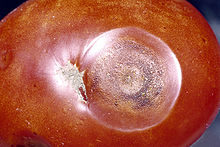
Anthracnose is a fungal disease that affects tomato and potato as well as plants in several other plant families including cucumber, onion and bean. The pathogen specific to tomato, Colletotrichum coccodes, usually infects ripe and and overripe fruit first but can also infect green fruit, and the stems, leaves and roots. The fungus causes small, circular, depressed spots that enlarge and may develop concentric rings. As the fungus produces spore-containing structures the spots become darker. When conditions are wet or humid, tan to orange spores are released and may be carried to other fruit in water. Eventually, the whole fruit will probably rot. The fungus can survive in the soil for long periods of time, and since it is spread by splashing water, can quickly infect the entire crop especially in warm, humid, wet conditions. Photo Credit Clemson University, Wikipedia
Control
- Remove infected plants immediately and dispose of them to reduce the spread of the fungus.
- Wash tools, hands, and clothing that may carry the disease.
- Use a 3 year crop rotation scheme with crops from other plant families
- Water in the morning using drip irrigation to reduce the time that moisture is on the leaves
- Mulch plants to reduce the effects of rain splashing spores onto plants
- Increase air circulation by increasing space between plants or trimming excess foliage
- Spray with a solution of 1 tablespoon baking soda, 2 1/2 tablespoons vegetable oil, and 1 teaspoon of liquid soap (not detergent) per gal of water. Repeat every 2 weeks, more often if rain washes the solution away.
- Spray with a prepared solution of Bacillus subtilis about every 2 weeks or when rain has washed it off the leaves.
- For very severe infestations spray with copper or sulfur, heeding cautionary warnings on the containers. These are more demanding solutions to the problem and the copper application will require special equipment.